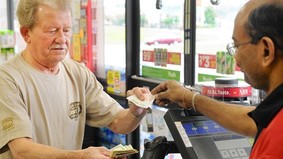(Submitted by Skepticality listener Chris Benson.)
I have two similar-ish stories:
1. In the fall of 1979 my family moved from Muscatine, Iowa to Kingman, AZ. It was the week before Halloween of my senior year and I was leaving behind a graduating class of 379.
On my first or second day at my new High School, I was walking down the hall and found myself looking at an acquaintance from my old High School class! We were both surprised, to say the least.
2. In the early ’80s I was at Arizona State and a friend of mine from our dorm needed a ride to the University of Arizona for an ROTC function. I had a friend from Kingman whom I knew was at U of A, but we had not spoken for a couple of years, and I had no other information, but figured I could go try to hunt him down.
I dropped my dorm-mate off at his ROTC thing and went to the Student Union to see if I could look my other friend up in a school directory. The fellow at the service desk in the Union said he couldn’t help me because they didn’t have a directory.
I knew driving down that it was a wild goose chase, but I was really disappointed.
Then I turned around trying to think of something else to try, and I’ll be damned if he wasn’t standing there. He was on his way to dinner at the Union’s cafeteria, and we spent a lovely evening together.
The population of that school was around 30,000 at the time, so I figure the odds were something close to that.
Below are the extended notes provided by contributing editor Mark Gouch for use in Skepticality Episode 258. Mark is a wastewater treatment system operator and engineer living in Smithtown, NY (Long Island). He started to become interested in coincidences after recognizing the series of events that conspired to get him employment on Long Island many years ago. Two of Mark’s recommended books include “The Drunkard’s Walk: How Randomness Rules Our Lives” by American physicist and author Leonard Mlodinow, and “The Hidden Brain: How Our Unconscious Minds Elect Presidents, Control Markets, Wage Wars, and Save Our Lives” by Shankar Vedantam.
Take a look and leave your comments below. Also, please be sure to listen to the podcast for our own hilarious commentary.
1. This is probably impossible to estimate numerical odds. So many factors affect everything that happens. For example way back in 1979, what were the economics of Iowa and Arizona? In general there has been a movement of people in the US to the sun belt. If some specific economic or other conditions made making the move desirable, that would make the chances of meeting someone who made a similar move greater.
2. I’m glad that this story happened over 25 years ago. I did not notice at first that Chris said it was in the ’80s. I was about to criticize him for not doing a web search, or look for a friend on the face thing, or do an on-line criminal records search or something, to try to find his friend. But since it was a long time ago, he will be spared that criticism. If he should run into a similar situation in this decade, we know he will avail himself of the various internet tools to increase odds of success again.
We are sure that it must have been surprising to find his friend. Trying to estimate the odds of doing so is probably not really possible. But I think that as usual, there are some factors that make the odds much better than we might intuitively think at first. And it is worth thinking about them.
Let’s think about a few possible items. There may be a lot of odds reducers that he did not mention. For example, I suspect his friend lived in a campus dormitory and he happened, on purpose, or by chance, to go to the student union at dinner time.
I suspect that since it was a friend he was looking for, they may have gone to high school together. This means that his friend most likely lived in a dorm at the campus. If so, then it would actually have been a great plan to try to find a campus dormitory-living student by going to the student union cafeteria at dinnertime. Or breakfast time or lunch time.
Now if the population of the school was around 30,000 at the time, and half of the students lived in a dorm, then your odds of finding the person would roughly double. That would be about 1 in 15,000 chance, which is pretty long odds.





